Serifos in Greece
Until very recent times, a study entitled Julian of Ascalon’s Treatise of Design and Construction Rules From Sixth-Century Palestine might have been categorized somewhere in-between ancient history and archeology of architecture, if not relegated to the dusty shelves of legal scholarship. Although it deals with one of the most sought-after secrets of architecture, how to build the charming Mediterranean towns of Greece, Spain, North Africa, the Near East and many other places, this is not immediately obvious from the content of the treatise. The reason for this is that the treatise does not so much describe the form of the town as the process for building it, and the process turns out to be emergent. Unless the reader makes the link from process to form, the rules described will make no more sense than the rules for a cellular automaton out of context.
It is tragic that enormous amounts of resources have been spent attempting to recreate the Mediterranean town with no clue as to the underlying source of its complexity. Montreal itself has the world famous Habitat 67, a confusing pastiche of the memories that architect Moshe Safdie brought back from his land of birth, which he had in common with Julian of Ascalon. Habitat 67 was intended to be a low-cost solution to housing, but it never was taken seriously as a model for urban habitat, and its current untrendiness spares it from being labeled fake complexity. That an attempt to emulate the architecture of some of the poorest people of previous centuries would result in an expensive failure testifies to the inadequacy of modern production processes, but also of the wealth inherent in those simple traditional production processes. The beauty resulting from large aggregations of simple buildings has turned many towns into tourist destinations. There is value in process.
The complexity demonstrated by the constructions of pre-modern civilizations may be a direct consequence of their material poverty. Most people will claim that the loss of building quality is a result of culture, and so we must change our own culture through education. That is not a complete answer. Cultures are stored in information technologies and media. The modern era coincides with the invention of printing, making it possible for the first time to reproduce information in large quantities at low costs. As information technologies have progressed and become more affordable, building processes have become increasingly dependent on large amounts of descriptive information, with blueprints describing in every minute detail how to compose a building. And now that CAD software can describe and store nearly limitless information, whole new forms of buildings have become possible.
All of this progress has only enabled builders to become lazier with information. Pre-modern builders, limited to oral communication and their brains to hold information, had to employ very sophisticated means of information compression to communicate and simply remember their cultures. This lead them to rely on simple processes the likes of which are behind the complexity in fractal geometry and cellular automata to build their environments - very short sequences of information that can be utilized to generate fully complex forms. Christopher Alexander even used as an example, in The Nature of Order, the production of a boat that had been coded into a song that the builders recited while creating the boat, adding a mnemotechnical aspect to the storage of cultural information that was essential to pre-modern survival.
Without knowing how traditional cultures were stored, we had no idea how to inspire ourselves from them. Modern and post-modern architects attempted in vain to imitate traditional building using their own, lazy information technologies, and succeeded only in building pastiche of complexity. The breakthroughs in complexity theory of the past decades finally gave us the opportunity to decode the mysteries of historic building cultures by showing us what kind of information to search for. What was right in front our noses suddenly becomes deeply meaningful.
It is to his great credit that Besim S. Hakim went looking specifically for the source of the emergent forms of Mediterranean towns in treatises of building laws. From his study of the treatise of Julian of Ascalon, but also of those of Muslim scholars around the Mediterranean, he was able to identify the underlying process that generates the complex morphology all towns of the region have in common, and that so many have sought to imitate. It is no exaggeration to call this pioneering work in complexity.
The space of Hakim's search began in the Islamic world, with the treatise of Ibn al-Rami from Tunis in circa 1350. Tracing the origins of the practices described in the treatise, references to treatises written in Egypt, Arabia, Tunisia and Andalusia in previous centuries were researched until the treatise of Julian of Ascalon was uncovered. Written in Palestine to describe the local building customs in order to provide the Byzantine empire with an improved legal system, this particular treatise's value is its longevity. After propagating throughout Greek civilization as part of a general book of laws (the Hexabiblos), its authority was invoked in decisions dating as recently as the 19th century. Hakim infers the origins of these shared practices, and the shared morphology of regions as far apart culturally, linguistically and geographically, as Andalusia, Greece and Palestine, to customs from ancient Babylonian civilization that had spread to the Eastern Roman Empire.
The goal shared by these treatises is a definition of urbanism as relevant today as it was in Babylon:
The goal is to deal with change in the built environment by ensuring that minimum damage occurs to preexisting structures and their owners, through stipulating fairness in the distribution of rights and responsibilities among various parties, particularly those who are proximate to each other. This ultimately will ensure the equitable equilibrium of the built environment during the process of change and growth. (Hakim, Mediterranean urban and building codes: origins, content, impact, and lessons, p. 24)
Here we see what the underlying error of Habitat 67 was. It was designed as a single static building imitating a process that made a living tissue out of many individual acts of simple building. The codes of the Mediterranean treat the town as a living, whole structure in movement that must be preserved while it achieves equilibrium with a changing environment and society.
Perhaps the most relevant conclusion of this research is the identification of proscriptive and prescriptive rules for building.
Proscription is an imposed restraint synonymous with prohibition as in 'Thou shalt not', for example, you are free to design and manipulate your property provided you do not create damage on adjacent properties. Prescription is laying down of authoritative directions as in 'Thou shalt', for example, you shall setback from your front boundary by (x) meters, and from your side boundaries by (y) meters regardless of site conditions. Byzantine codes in many instances included specific numeric prescriptions, unlike their Islamic counterparts that tended not to include them. (Hakim, Mediterranean urban and building codes: origins, content, impact, and lessons, p. 26)
A prescription would be a rule that defines in detail what to do in a given situation. A proscription is a template for defining prescriptive rules, a pattern for a rule. Muslim scholars provided mainly proscriptions, but Julian of Ascalon's treatise was highly prescriptive. Julian was describing in details the local building codes with the idea that they would be used to devise proscriptive rules for the empire. By accident these prescriptive rules became law and remained in force for centuries until their inability to deal with society or physical conditions radically different from sixth century Palestine made them obsolete. Although it means the codes failed to deal with changing circumstances, this gives us the chance to bridge the gap between the physical structure of built towns and the rules that generate them.
The concept of proscriptive rules also helps explain why so many different cultures with specific structural typologies can generate such similar morphology. Hakim uses as an example the problem of views. The Greeks were preoccupied with views of the sea, and their prescriptive rules obliged the preservation of view corridors in new constructions. Muslims, on the other hand, were preoccupied with the preservation of privacy and the prevention of intrusive views from one property to another. This would have very different results structurally, however those two prescriptive rules are based on the same underlying proscription. Local customs and culture could therefore be translated into prescriptive rules using the proscriptions inscribed in building treatises and the emergent morphology of those proscriptions would be symmetric from one culture to the next, while being fully adapted to local conditions.
Another significant fact that strikes out from these treatises is the importance of relationships between neighbors. The Julian of Ascalon treatise describes how to literally embed houses into each other, ultimately making them one continuous, somewhat random building created through iterated steps. But most importantly by proscribing rules as relevant to a neighborhood, Mediterranean urbanism avoids the problem of the absolutist, dare I say "Cartesian" rules of modern planning that are relative to the precisely subdivided lot the building is on. Hakim shows the wastefulness of latter rules in a comparison of the old town of Muharraq in Bahrain with a new subdivision from modern Muharraq.
The town on the left was generated using proscriptions based on neighbors, while the subdivision on the right used absolute rules planned with the subdivision. Notice that the configurations on the right waste much of the space in order to achieve a strictly Cartesian, grid-like morphology that no doubt looks orderly to the planners.
The last item of significance, and perhaps the most revolutionary, is how the proscriptions extracted by Hakim are similar in nature to the rules that Stephen Wolfram described to generate emergent complexity with cellular automata. He himself follows a proscription/prescription system, where the proscription is for example the 2 color, one-dimension elementary cellular automaton that made him famous, for which there exist 256 different prescriptive rules of neighborhood, some of which grow in time to make two-dimensional chaotic fractals. Some urban complexity researchers such as Michael Batty have been playing with cellular automata trying to reproduce urban form, but their efforts have taken them on the wrong track. The codes of historic towns behave in the same manner as a cellular automaton. This should be the focus of their research.
Whatever the potential for research, the proscriptions discovered by Besim S. Hakim are still relevant today and can be used to create the prescriptions that we need to implement an emergent urbanism relevant to the problems of today, that is to say the creation of a sustainable city and living urban tissue out of the vast urban fabric of suburban sprawl. Hakim has so far focused his work on the regeneration of historic neighborhoods by restoring the generative codes that produced them, but there is a vast potential to expand his work to non-historic neighborhoods that are in dire need of new life.
Addendum
Four regions, four cultures, one shared process generating a symmetric morphology
Tunisia
Andalusia
Greece
Palestine
Reference
Besim S. Hakim - Generative processes for revitalising historic towns or heritage districts
Besim S. Hakim - Julian of Ascalon's Treatise of Construction and Design Rules from Sixth Century Palestine
Besim S. Hakim - Mediterranean urban and building codes: origins, content, impact, and lessons
and don't forget to look at Besim S. Hakim's website.
Mr. Besim S. Hakim provided comments for this article
Picture from Alessandra Scarano were also used







Comments
Wonderful read!
I agree that Prof. Hakim's fine distinction between proscriptive vs. prescriptive codes has dramatic applications in the way we ground an approach to urbanism today. I'd be game to follow any further erudition on your last suggestion.
I think New Urbanists attempt to achieve generative urbanism through proscriptive means with the Transect, but end up falling into Julian's trap the more they attempt to indoctrinate with pattern books or rely on overly-prescriptive urban design codes/review processes to affect their ends. (Of course, the Transect does not a city make,...but that's another issue.)
There are also proscriptive processes embedded in all forms of art and self-expression...The room provided for self-expression should not be forgotten in your work. Julian Beinart, for example, did wonderful work on the tacit proscriptive processes at work with mural painting in Johannesburg's shanty towns. Something of that process is implicit in the way suburbanites decorate their lawns for very dissimilar reasons.
You might be interested to know that Louis Kahn advocated a return to proscriptive Mediterranean "vista zoning" for the overlooking ridges surrounding the Old City of Jerusalem. He had a wonderful way of looking at the street as a space for "cross-invitation"...a place of "agreement"...some of this which, to be fair to Moshe Safdie, was executed in spirit when he followed Kahn's plan for the rebuilding of the Jewish Quarter in the Old City.
Very interestingly, there are very notable exceptions to proscriptive approaches in Mediterranean town planning which can be found in the utopian literature of apocalyptic sects. The first modernists. The New Jerusalem Scroll of the absolutist Essene sect that produced the Dead Sea Scrolls depicts a "Cartesian" paradise.
I think the problem with New Urbanist codes is not that they are prescriptive - ultimately all codes need to become prescriptive in order to be effective - but that they are Cartesian instead of contextual. A rule like "Specific to zone T3, a. A minimum of two trees shall be planted within the first Layer for each 30 feet of Frontage Line or portion thereof." is not adaptive to context.
A very interesting blog - even for a nonarchitect!
http://trinklebean.wordpress.com